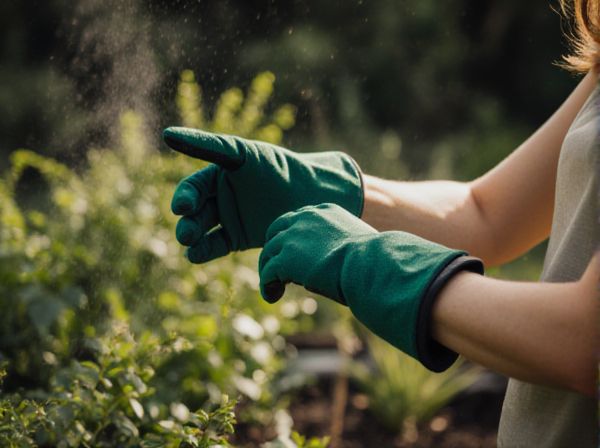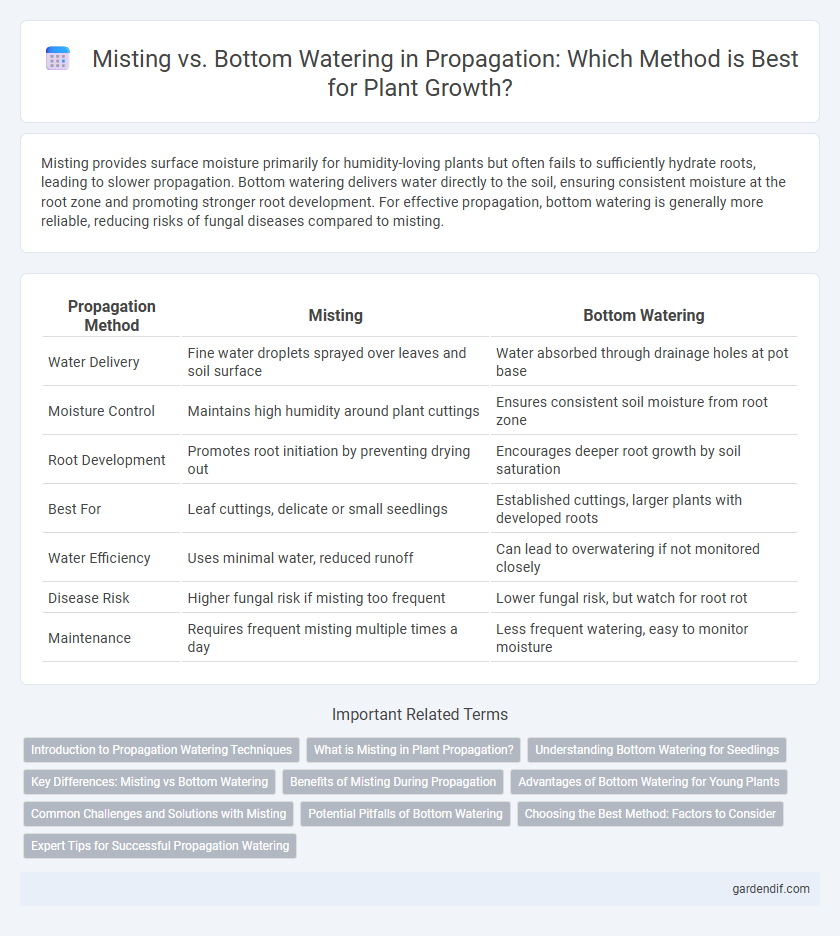
Misting vs Bottom watering Illustration
Misting provides surface moisture primarily for humidity-loving plants but often fails to sufficiently hydrate roots, leading to slower propagation. Bottom watering delivers water directly to the soil, ensuring consistent moisture at the root zone and promoting stronger root development. For effective propagation, bottom watering is generally more reliable, reducing risks of fungal diseases compared to misting.
Table of Comparison
| Propagation Method | Misting | Bottom Watering |
|---|---|---|
| Water Delivery | Fine water droplets sprayed over leaves and soil surface | Water absorbed through drainage holes at pot base |
| Moisture Control | Maintains high humidity around plant cuttings | Ensures consistent soil moisture from root zone |
| Root Development | Promotes root initiation by preventing drying out | Encourages deeper root growth by soil saturation |
| Best For | Leaf cuttings, delicate or small seedlings | Established cuttings, larger plants with developed roots |
| Water Efficiency | Uses minimal water, reduced runoff | Can lead to overwatering if not monitored closely |
| Disease Risk | Higher fungal risk if misting too frequent | Lower fungal risk, but watch for root rot |
| Maintenance | Requires frequent misting multiple times a day | Less frequent watering, easy to monitor moisture |
Introduction to Propagation Watering Techniques
Misting maintains high humidity around cuttings, promoting root development without waterlogging, essential for delicate propagation stages. Bottom watering delivers moisture directly to the root zone, encouraging strong root growth and reducing fungal risks by keeping foliage dry. Both techniques optimize hydration for successful propagation but suit different plant types and environmental conditions.
What is Misting in Plant Propagation?
Misting in plant propagation is the technique of spraying a fine layer of water onto the leaves and stems to maintain humidity and prevent dehydration in cuttings. This method helps create an optimal microenvironment that supports root development by reducing moisture loss and stress on young plants. Compared to bottom watering, misting ensures constant moisture on the aerial parts, which is crucial during the initial stages of propagation.
Understanding Bottom Watering for Seedlings
Bottom watering for seedlings involves placing pots in a shallow tray filled with water, allowing the soil to absorb moisture through drainage holes, which promotes even hydration and reduces the risk of fungal diseases compared to misting. This method ensures consistent soil saturation without disturbing delicate roots or seedlings, encouraging stronger root development and healthier growth. Bottom watering is especially effective for seed-starting trays and containers with well-draining media, optimizing moisture retention and nutrient uptake.
Key Differences: Misting vs Bottom Watering
Misting involves spraying water directly onto plant leaves and soil surface, promoting humidity and reducing drought stress, while bottom watering delivers moisture through the pot's drainage holes, encouraging deeper root growth and preventing overwatering. Misting requires frequent application to maintain moisture levels, making it ideal for delicate cuttings and propagation trays, whereas bottom watering conserves water by allowing roots to absorb only what they need. The key distinction lies in moisture delivery method: surface hydration versus root-zone absorption, impacting plant health and propagation success.
Benefits of Misting During Propagation
Misting during propagation enhances humidity around cuttings, promoting faster root development and reducing transplant shock. This method maintains consistent moisture without waterlogging the substrate, preventing fungal growth and root rot. Misting also encourages healthy leaf tissue expansion and improves nutrient absorption essential for new plant growth.
Advantages of Bottom Watering for Young Plants
Bottom watering ensures consistent moisture levels by allowing young plants to absorb water directly at the root zone, reducing the risk of fungal diseases common with surface watering. This method promotes stronger root development and minimizes soil compaction, leading to healthier seedlings and improved nutrient uptake. By avoiding wetting the foliage, bottom watering also decreases the likelihood of mold and damping-off, enhancing overall propagation success.
Common Challenges and Solutions with Misting
Misting often leads to inconsistent moisture levels, which can cause fungal growth and damping-off in seedlings during propagation. To prevent these issues, use a fine mist setting and ensure adequate airflow around plants to reduce excess humidity. Monitoring soil moisture regularly and supplementing misting with bottom watering can create a balanced environment that promotes healthy root development.
Potential Pitfalls of Bottom Watering
Bottom watering can lead to over-saturation of soil, creating a consistently wet environment that promotes root rot and fungal diseases. This method may also prevent proper oxygen exchange at the root level, resulting in poor root development and plant stress. In contrast, misting provides a gentle, controlled moisture delivery that reduces these risks while supporting healthy propagation.
Choosing the Best Method: Factors to Consider
Choosing the best propagation watering method depends on factors like plant species, environment humidity, and root development stage. Misting offers gentle hydration and increases air moisture, ideal for delicate cuttings and seedlings prone to damping-off diseases. Bottom watering promotes deeper root growth by encouraging roots to seek moisture downward, making it suitable for established cuttings and reducing surface mold risk.
Expert Tips for Successful Propagation Watering
Expert tips for successful propagation watering emphasize misting to maintain humidity and prevent soil disturbance, promoting delicate root development in cuttings. Bottom watering ensures consistent moisture absorption, reducing fungal risks by keeping foliage dry and encouraging deeper root growth. Combining both methods strategically enhances propagation success by balancing moisture levels and minimizing stress on young plants.
Misting vs Bottom watering Infographic

 gardendif.com
gardendif.com